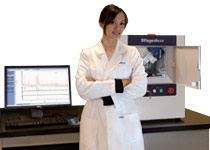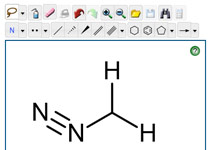| XtaLAB mini™ – Benchtop chemical crystallography system
|
 |
| For small molecule 3D molecular structure determination |
The Rigaku XtaLAB mini benchtop X-ray crystallography system is a compact single crystal X-ray diffractometer designed to produce publication-quality 3D structures. The perfect addition to any synthetic chemistry laboratory, the XtaLAB mini will enhance research productivity by offering affordable structure analysis capability without the necessity of relying on a departmental facility. With the XtaLAB mini, you no longer have to wait in line to determine your structures. Instead your research group can rapidly analyze new compounds as they are synthesized in the lab.
For more > |
|
| MiniFlex – qualitative and quantitative analysis of polycrystalline materials |
 |
| Benchtop X-ray diffraction (XRD) instrument |
Ideally suited for today's fast-paced XRD analyses, the fifth generation MiniFlex delivers speed and sensitivity through innovative technology enhancements such as the optional D/teX high speed detector coupled with a 600 W X-ray source. Whether used for teaching X-ray diffraction at the college and university level, or routine industrial quality assurance, the MiniFlex delivers both performance and value.
For more > |
|
| Video of the Month |
 |
WINNER OF THE 2014 LAB GRAMMY AWARD!!!
Bohemian Rhapsody
Laboratory Parody |
A parody of the song "Bohemian Rhapsody" by Queen recorded and sung and produced by James Clark (Lecturer in Aerospace Medicine, KCL). The video was recorded with the generous help of the staff and students of the Rayne Institute, King's College London.
Watch the video > |
|
| Conferences and Workshops |
 |
Join Rigaku
at future meetings |
Rigaku will be sponsoring, attending or exhibiting at the following conferences and trade shows:
(MRS) Materials Research Society, Boston, MA, USA,
November 29 – December 4, 2015
AsCA, Kolkata, India,
December 5 – 8, 2015
See the complete list >
|
|
| Useful link of the Month |
 |
| ChemStable |
| ChemStable is a free web server for in silico prediction of compound chemical unstability based on Bayesian modeling and atomic centered fragment generation method. The prediction model was constructed based upon a data set of 9,746 structurally diverse compounds with experimental chemical stability data in DMSO/H2O solutions stored at 50°C for 105 days. To use ChemStable, simply draw a chemical structure in the Chemdoodle window or upload a library in SDF.
For more >
|
|
| Planning to Submit a Grant? |
 |
| Rigaku is happy to assist |
| If you are planning on submitting an instrument grant proposal, Rigaku will be happy to assist you. We can help you determine the correct instrument and configuration best suited for your analytical needs.
Start the process >
|
|
| Rigaku's Materials Analysis eNewsletter, The Bridge |
 |
| Join us |
| Each month, Rigaku distributes two eNewsletters: The Bridge, which focuses on Materials Analysis, and Crystallography Times, which concentrates on life sciences.
Register >
|
|
|
|
Welcome
This month's issue of The Bridge is being sent out early on account of the Thanksgiving holiday in the United States next week. Next month, Rigaku will attend four major international events. I invite everyone who can come to visit us at one of these exhibits: the (MRS) Materials Research Society meeting from Nov 29 to Dec 4 in Boston, the Asian Crystallographic Association (AsCA) meeting from Dec 5 – 8 in Calcutta, the American Geophysical Union meeting from Dec 14 – 18 in San Francisco, and PACIFICHEM from Dec 15 – 20 in Honolulu. A complete listing of Rigaku events may be found on our web site.
For your continuing education, we offer the fourth installment of our new series "Introduction to single crystal X-ray analysis," entitled "Data Collection and Processing." Our featured technical paper is a primer on 'X-ray Thin-film Measurement Techniques.' For your scientific amusement, this month's video is the winner of the 2014 Lab Grammy award. Check out the news and papers sections at the bottom of the page for the latest developments in materials science. Enjoy the newsletter.
R.C. Tisdale, Ph.D. – Editor
 |
|
Introduction to Single Crystal X-ray Analysis IV
Data Collection and Processing
Rigaku Corporation
Data collection and processing have a significant impact on the structure analysis step. Considering the power of current direct method programs, quality data are nearly equal in importance to obtaining the initial structure when crystallographic difficulties such as an
ambiguous space group and twining are not involved. This article will describe problems and measures in obtaining diffraction data using two-dimensional detectors: a CCD and an IP detector.
For more > |
 |
|
Featured XRD Rigaku Journal Article
X-ray Thin-film Measurement Techniques
Rigaku Corporation
There is a flood of high-tech functional devices made up of thin films. Cell phones and personal computers are integrated units of thin film devices, so are TV displays, recording media such as CD/DVD, their write/playback apparatuses, etc. X-ray measurement techniques are widely used for characterizing various thin-film materials and devices. For more > |
 |
|
Featured XRF Rigaku Journal Article
Micro-Z ULS: Excellent Performance for Ultra-low Sulfur Analysis in Petroleum
Rigaku Corporation
The newly released wavelength-dispersive X-ray fluorescence sulfur analyzer, Micro-Z ULS (Ultra Low Sulfur) meets the current needs for the analysis of sulfur in petroleum. The sulfur content in gasoline needs to be controlled in order to reduce air pollution, lengthen the lifetime of automobile catalysts, and improve engine reliability. For more > |
 |
|
XRD Application Note – 1
Particle Diameter Distribution of Subnano Gold Particles Using the Small-angle X-ray Scattering Method
Rigaku Corporation
By using the small-angle X-ray scattering method, it is possible to evaluate the size distribution of powders, microparticles
dispersed in liquid, and particles/pores distributed in thin films. In particular, it is possible to evaluate the average size and
distribution of sub-nanometer particles, which are difficult to evaluate with a TEM (Transmission Electron Microscope) or
DLS (Dynamic Light Scattering). In this case, we evaluated the size distribution of gold nanoparticles dispersed in organic
solvent. For more > |
 |
|
XRD Application Note – 2
Quantification of Trace Crystal Polymorph Components Using a High-speed 1-dimensional Detector
Rigaku Corporation
Materials with the same chemical formula but different crystal structures are called crystal polymorphs. Since an X-ray
diffraction profile depends on the crystal structure of the measured material, X-ray diffraction measurement is used to
evaluate crystal polymorphs. Here we show an example in which a trace component of anatase (TiO2) contained in
titanium oxide with a rutile (TiO2) structure, sold commercially as a reagent, was evaluated with the standard addition
method by using a high-speed 1-dimensional detector.
For more > |
 |
|
WDXRF Application Note
Quantitative Analysis of Soda-lime Glass with Supermini200
Rigaku Corporation
X-ray fluorescence (XRF) analysis quickly and easily offers precise elemental analysis results allowing con-trol of glass composition in the production process. This application note describes the excellent performance of Supermini200 for the analysis of soda-lime glass. For more > |
 |
|
EDXRF Application Note
Analysis of Sulfur, Vanadium and Nickel in Crude Oil
Applied Rigaku Technologies
Sulfur, vanadium and nickel occur naturally in crude oil, and their concentrations vary depending on the geographical region of the oil deposits. High levels of vanadium and nickel can foul the refining process during cracking, and so crude oil with low levels of vanadium and nickel is desirable and high levels must be removed before
refining. At the refinery as well as midstream at pipelines and gathering points, a quick and easy means of screening and monitoring for vanadium and nickel is a valuable tool in characterizing the quality of the crude before refining.
For more > |
 |
|
Raman Application Note
Detection of Homemade Explosives Using Handheld Raman
Rigaku Raman Technologies
As commercial explosives become more difficult to obtain, terrorists turn to producing homemade explosives (HMEs). HMEs are typically produced in makeshift labs using materials that can be easily obtained by the public. Because HMEs are synthesized under improvised conditions, the product typically contains impurities, many of
which color the sample and produce fluorescence so they cannot be analyzed using previous generation 785 nm Raman-based systems. Handheld Raman using 1064 nm excitation reduces fluorescence interference and allows for many of these HMEs to be easily identified in the field with little or no sample preparation. For more > |
 |
|
Scientific Book Review
The Invention of Nature: Alexander von Humboldt:s New World
By Andrea Wulf
Although the subtitle suggests that The Invention of Nature is only about the New World, the book covers much more: Humboldt:s early life, his trip to the new world, his attempts to visit the Himalayas stymied by the East India Company, a substitute trip to Siberia, his interactions with the scientists of his day, his publications that provided tremendous information to the general public and his later life in Berlin. The epilogue discusses one of the repercussions of WWI???the purge of everything German from many places around the world. Humboldt:s current obscurity arises from his Prussian heritage and use of the German language.
For more > |
 |
|
Material Analysis in the News
News for November 2015
November 1, 2015. The Air Force Research Laboratory's Environmental Technology Program and Coating Technology Integration Office are playing a critical role in the discovery of environmentally-safer inorganic coatings solutions for protecting and extending the life of aluminum landing gear components in U.S. Air Force aircraft.
November 3, 2015. Scientists in Japan have created a new type of glass stronger than most metals and nearly as tough as steel. The glass is made by infusing silicon dioxide with alumina, an aluminum oxide. Traditional glass-making technologies complicate the introduction of alumina during the formation process, but scientists at the University of Tokyo's Institute of Industrial Science solved this problem by developing a way to push alumina into the silicon dioxide using gases.
November 3, 2015. A research team led by Dr. Han Liyuan, director of the Photovoltaic Materials Unit at Japan's National Institute for Materials Science, has developed the world's first method to fabricate high-quality perovskite materials capable of utilizing long-wavelength sunlight of 800 nm or longer. Compared to conventional methods, this method enables the creation of perovskite materials that have a 40 nm wider optical absorption spectrum, a high short-circuit current and high open-circuit voltage.
November 4, 2015. A research team led by Xiaoqin Elaine Li, an associate professor in the Department of Physics at The University of Texas at Austin, has been awarded a grant of $2 million over the next four years from the National Science Foundation (NSF) to research and develop thin, flexible semiconductors that might eventually lead to bendable computer screens and wearable electronics.
November 9, 2015. Researchers at Florida State University have discovered a method of using manganese oxide – also known as birnessite – to capture sunlight and then use that solar energy to create an oxidation reaction, breaking down water (H2O) into hydrogen (H) and oxygen (O2). Oxidation occurs during photosynthesis, and by replicating this part of the natural process, scientists might be able to produce energy in new ways via a simple, practical mechanism.
November 12, 2015. Chinese researchers have developed a material called an "active frequency selecting surface" (AFSS) – a thin layer of material covered with a substance used in printed circuit boards that can be "tuned" to absorb microwaves at a range of frequencies. The material could be used to reduce the radar cross-section of whatever it covers.
November 13, 2015. Theoretical physicists from Imperial College London have devised an extremely rapid heating mechanism that they believe could heat certain materials to ten million degrees in much less than a million millionth of a second. The method could be relevant to new avenues of research in thermonuclear fusion energy, where scientists are seeking to replicate the Sun's ability to produce clean energy.
November 17, 2015. Researchers have used an infrared laser to cool crystals in water by about 2°C, a discovery that could help "point cool" tiny areas with a focused point of light. One application might allow scientists to precisely cool a portion of a cell as it divides to slow these rapid processes for observation purposes.
November 17, 2015. A new symmetry operation developed by Penn State researchers led by Venkat Gopalan, Professor of Materials Science and Engineering, has the potential to speed up the search for new advanced materials that range from tougher steels to new types of electronic, magnetic, and thermal materials. With further developments, this technique could also impact the field of computational materials design.
|
 |
|
Recent Scientific Papers of Interest
Papers for November 2015
Recent Scientific Papers of Interest is a monthly compilation of material analysis papers appearing in recently released journals and publications. See below |
Diffraction: Principles and application. Hansen, Thomas C. EPJ Web of Conferences. 2015, Vol. 104, p01002-p.1-01002-p.53. 53p. DOI: 10.1051/epjconf/201510401002.
Atomic spectrometry update. Review of advances in the analysis of metals, chemicals and functional materials. Carter, Simon; Fisher, Andy; Garcia, Raquel; Gibson, Bridget; Lancaster, Steve; Marshall, John; Whiteside, Ian. Journal of Analytical Atomic Spectrometry. Nov2015, Vol. 30 Issue 11, p2249-2294. 46p. DOI: 10.1039/c5ja90045j.
Leonardo da Vinci's drapery studies: characterization of lead white pigments by µ-XRD and 2D scanning XRF. Gonzalez, Victor; Calligaro, Thomas; Pichon, Laurent; Wallez, Gilles; Mottin, Bruno. Applied Physics A: Materials Science & Processing. Nov2015, Vol. 121 Issue 3, p849-856. 8p. DOI: 10.1007/s00339-015-9365-z.
Local structure studies using the pair distribution function.
Bordet, Pierre. EPJ Web of Conferences. 2015, Vol. 104, p01003-p.1-01003-p.14. 14p. DOI: 10.1051/epjconf/20159901003.
Carbothermal synthesis of LiVPO4F and its structural change in a broad potential range observed by in-situ X-ray diffraction. Li, Peng; Wang, Pengfei; Yu, Haoxiang; Lin, Xiaoting; Shao, Lianyi; Shui, Miao; Long, Nengbing; Shu, Jie. Ceramics International. Nov2015 Part A, Vol. 41 Issue 9, p10766-10774. 9p. DOI: 10.1016/j.ceramint.2015.05.012.
Unconventional silica source employment in zeolite synthesis: Raw powder glass in MFI synthesis case study. Vinaches, Paloma; Rebitski, Ediana P.; Alves, José Antônio B.L.R.; Melo, Dulce M.A.; Pergher, Sibele B.C. Materials Letters. Nov2015, Vol. 159, p233-236. 4p. DOI: 10.1016/j.matlet.2015.06.120.
Effect of Pressure on Valence and Structural Properties of YbFe2Ge2 Heavy Fermion Compound. A Combined Inelastic X-ray Spectroscopy, X-ray Diffraction, and Theoretical Investigation. Kumar, Ravhi S.; Svane, Axel; Vaitheeswaran, Ganapathy; Kanchana, Venkatakrishnan; Antonio, Daniel; Cornelius, Andrew L.; Bauer, Eric D.; Yuming Xiao; Chow, Paul. Inorganic Chemistry. 11/2/2015, Vol. 54 Issue 21, p10250-10255. 6p. DOI: 10.1021/acs.inorgchem.5b01534.
In situ X-Ray diffraction study of hydrogen sorption in V-rich Ti–V–Cr bcc solid solutions. Planté, Damien; Andrieux, Jérôme; Laversenne, Laetitia; Miraglia, Salvatore. Journal of Alloys & Compounds. 11/5/2015, Vol. 648, p79-85. 7p. DOI: 10.1016/j.jallcom.2015.05.254.
Characterization and amorphous phase formation of mechanically alloyed Co60Fe5Ni5Ti25B5 powders. Avar, Baris; Ozcan, Sadan. Journal of Alloys & Compounds. Nov2015, Vol. 650, p53-58. 6p. DOI: 10.1016/j.jallcom.2015.07.268.
An estimation of the correctness of XRD results obtained from the analysis of materials with bimodal crystallite size distribution. Uvarov, Vladimir; Popov, Inna. CrystEngComm. 11/21/2015, Vol. 17 Issue 43, p8300-8306. 7p. DOI: 10.1039/c5ce01799h.
XRD characterization of mechanically alloyed high-nitrogen nanocrystalline Fe–Cr system. Dorofeev, G.A.; Lubnin, A.N.; Ulyanov, A.L.; Kamaeva, L.V.; Lad'yanov, V.I.; Pushkarev, E.S.; Shabashov, V.A. Materials Letters. Nov2015, Vol. 159, p493-497. 5p. DOI: 10.1016/j.matlet.2015.08.050.
A method for diffraction-based identification of amorphous sp2 carbon materials. Neverov, V.S.; Borisova, P.A.; Kukushkin, A.B.; Voloshinov, V.V. Journal of Non-Crystalline Solids. Nov2015, Vol. 427, p166-174. 9p. DOI: 10.1016/j.jnoncrysol.2015.07.025.
Analysis of sculptures using XRF and X-ray radiography. Calza, C.; Oliveira, D.F.; Freitas, R.P.; Rocha, H.S.; Nascimento, J.R.; Lopes, R.T. Radiation Physics & Chemistry. Nov2015, Vol. 116, p326-331. 6p. DOI: 10.1016/j.radphyschem.2015.04.012.
Determination of iron in uranium matrix using energy dispersive X-ray fluorescence (EDXRF) technique. Biswas, Sujoy; Rupawate, V.; Hareendran, K.; Roy, S. Journal of Radioanalytical & Nuclear Chemistry. Nov2015, Vol. 306 Issue 2, p543-548. 6p. 1 Color Photograph, 1 Diagram, 5 Charts, 1 Graph. DOI: 10.1007/s10967-015-4131-4.
Spatial distribution of physico-chemical properties and function of heavy metals in soils of Yelagiri hills, Tamilnadu by energy dispersive X-ray florescence spectroscopy (EDXRF) with statistical approach. Chandrasekaran, A.; Ravisankar, R. Spectrochimica Acta Part A: Molecular & Biomolecular Spectroscopy. Nov2015, Vol. 150, p586-601. 16p. DOI: 10.1016/j.saa.2015.05.083.
New developments of X-ray fluorescence imaging techniques in laboratory. Tsuji, Kouichi; Matsuno, Tsuyoshi; Takimoto, Yuki; Yamanashi, Masaki; Kometani, Noritsugu; Sasaki, Yuji C.; Hasegawa, Takeshi; Kato, Shuichi; Yamada, Takashi; Shoji, Takashi; Kawahara, Naoki. Spectrochimica Acta Part B. Nov2015, Vol. 113, p43-53. 11p. DOI: 10.1016/j.sab.2015.09.001.
On-site quantitation of arsenic in drinking water by disk solid-phase extraction/mobile X-ray fluorescence spectrometry. Hagiwara, Kenta; Koike, Yuya; Aizawa, Mamoru; Nakamura, Toshihiro. Talanta. Nov2015, Vol. 144, p788-792. 5p. DOI: 10.1016/j.talanta.2015.07.002.
Analysis of precious metals at parts-per-billion levels in industrial applications. Tickner, James; O'Dwyer, Joel; Roach, Greg; Smith, Michael; Van Haarlem, Yves. Radiation Physics & Chemistry. Nov2015, Vol. 116, p43-47. 5p. DOI: 10.1016/j.radphyschem.2015.01.006.
Solid residues from Italian municipal solid waste incinerators: A source for "critical" raw materials. Funari, Valerio; Braga, Roberto; Bokhari, Syed Nadeem Hussain; Dinelli, Enrico; Meisel, Thomas. Waste Management. Nov2015, Vol. 45, p206-216. 11p. DOI: 10.1016/j.wasman.2014.11.005.
Spatial variation of PM elemental composition between and within 20 European study areas – Results of the ESCAPE project.Tsai, Ming-Yi; Hoek, Gerard; Eeftens, Marloes; de Hoogh, Kees; Beelen, Rob; Beregszászi, Timea; Cesaroni, Giulia; Cirach, Marta; Cyrys, Josef; De Nazelle, Audrey; de Vocht, Frank; Ducret-Stich, Regina; Eriksen, Kirsten; Galassi, Claudia; Gražuleviciene, Regina; Gražulevicius, Tomas; Grivas, Georgios; Gryparis, Alexandros; Heinrich, Joachim; Hoffmann, Barbara. Environment International. Nov2015, Vol. 84, p181-192. 12p. DOI: 10.1016/j.envint.2015.04.015.
Rapid screening of anti-infective drug products for counterfeits using Raman spectral library-based correlation methods. Loethen, Yvette L.; Kauffman, John F.; Buhse, Lucinda F.; Rodriguez, Jason D. Analyst. 11/7/2015, Vol. 140 Issue 21, p7225-7233. 9p. DOI: 10.1039/c5an01679g.
Grazing-incidence small-angle X-ray scattering in a twofold rough-interface medium: a new theoretical approach using the q-eigenwave formalism. Chukhovskii, F. N.; Roshchin, B. S. Acta Crystallographica. Section A, Foundations & Advances. Nov2015, Vol. 71 Issue 6, p612-627. 16p. DOI: 10.1107/S2053273315016666.
|


















